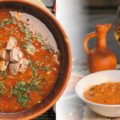Russians love soup. It is estimated that around 30 billion soup servings are consumed in Russia annually, more than in any other European country. This is no surprise since the Russian cuisine has numerous recipes for delicious soups.
Ancestral recipe
Although the word “soup” came into the Russian language only during the reign of Peter the Great, the history of Russian soups is much older. Shchi can be considered the forebear of all main courses in Russia. The term used to refer to all vegetable slop or bouillon made of boiled vegetables. The recipe is so simple and universal that such soup was often frozen and taken along by travelers, because it could be easily warmed up and consumed. There is also a term “sour shchi” that denotes a drink, a heavily fermented bread kvass. It was used as a base for a soup of the same name.
In other words, shchi was the main hot meal both in poor peasant huts and in wealthy mansions. Not surprisingly so, since a pot of such soup could feed the whole family, including the youngest and the oldest members who cannot eat solid food. Key ingredient in shchi is cabbage, fresh or fermented. It gives the soup its famous flavor. Depending on other products, shchi could be “rich”, with meat, or “empty”, made only of vegetables. Shchi is still a very popular dish in Russian families, although now people usually saute onions and carrots before putting them in the saucepan. This was not part of the traditional recipe, because shchi used to be made in a stone oven, where veggies were cooked in a ceramic or cast-iron pot, giving their aroma to the broth and becoming soft yet crunchy. But if you use a modern cooker, some adjustments are justified.
Borsch is perhaps the most well-known soup in Russia, although this is not a purely Russian dish — other countries such as Ukraine, Poland, Romania and Moldavia have their own variations of borsch. Borsch is easily recognizable for its rich red color that comes from beetroot, a must-have ingredient in borsch along with cabbage. The quality of this soup largely depends on a chef’s ability to preserve its color, this is why beet is often sprinkled with vinegar or lemon juice while sautéing. Borsch is usually prepared using meat-and-bone broth, but there are also vegan recipes, with beans or mushrooms. For better taste, borsch is best served with sour cream, rye bread and a piece of lard.
Traditional Russian cuisine is known for its wide use of brines, and this tradition has been preserved up to this day. Pickles and brine are part of two popular Russian soups, rassolnik and solyanka. Solyanka is a thick and very nutritious soup made of various kinds of meat without cereals or potatoes. Rassolnik, or pickle soup, is a spicy soup with characteristic sourness, known for its thickness thanks to pearl barley or rice.
Russian rivers have always been abundant with fish, and therefore fish soup, or ukha, is a very popular dish. Such soup requires less ingredients compared to meat soups, but it’s harder to strike a balance: fish broth needs to be thick, but without notable fish scent. Fish is added to boiling water together with an onion and carrots, and then poached without a cover. It is important to preserve the fish juicy and springy. There is a great number of fish soup varieties. The Arkhangelsk, or Pomor ukha is one of the most interesting ones. It is made of cod or halibut, and then milk and butter are added to the ready dish. This feature comes from Finnish cuisine with its traditional creamy fish soup lohikeitto. Another interesting variety of fish soup, the Don ukha, is prepared using fresh tomatoes.
The Taste of Summer
In summer, cold soups were favored over hot broths. One of traditional seasonal Russian cold soups was botvinia. Today, this recipe is almost completely forgotten, but in the 19th century, botvinia was called the queen of Russian cold soups. It was made from the leaves of root crops, primarily beet tops. The leaves were chopped, blanched, pressed through a sieve, and then mixed with kvass, chopped cucumbers or pickles, onions, and beets. Botvinia is always served with boiled or salted and smoked fish and crayfish tails. When served without fish, the dish was considered incomplete. This soup is a record holder for the number of mentions in the Russian literature. Even the famous poet Alexander Pushkin once wrote in a letter to his wife that he served botvinia to his brother and he “gulped down two plates and devoured sturgeon.”
Svekolnik, a cold beet soup, can be called the summer version of borscht. It is made from chilled beet broth mixed with boiled carrots and potatoes, cucumbers, scallions, and dill. Before serving, it is usually garnished with a sliced boiled egg and sour cream.
And finally, the Russian favorite summer soup, okroshka. It is basically a mixture of finely chopped meat of various kinds, seasonal vegetables (boiled potatoes, cucumbers, and radish), and herbs (scallions, dill, and parsley) filled with unsweetened kvass. From the 18th to the 19th century, it was made with meat left over from previous meals and could include, for example, pork, turkey, and quail. Later, the recipe got simpler and started to include just one kind of meat, and in Soviet times, women even came to replacing meat with boiled sausages. Okroshka is usually garnished with sour cream. Instead of kvass, it can be served with kefir, a popular Russian milk drink. Both options result in a light cold soup with a refreshing soury taste, which is a perfect dinner for a hot day.
A Mixture of Cultures
Russia has always been a mixing pot of cultures, especially during Soviet times. Hence, its cuisine incorporated some recipes typical of the Caucasus. For example, the famous Georgian soup kharcho. The classic recipe requires beef, tklapi (pureed Tkemali plum roll-up fruit leather), and chopped walnuts. But tklapi isn’t very common in central Russia, so it was replaced with tkemali sauce or even tomato paste. The original kharcho is made without cereals as it is already very thick and is served with wheat or corn bread, which is dipped into the dish. Rice was added to the recipe “for bellyful” in Soviet times. What remained intact was the generous use of spices and herbs: kharcho suneli, khmeli suneli, or utskho suneli, dried barberry, garlic, and cilantro. They are the reason this soup has its distinctive spicy taste.
Another popular soup that originated in Tatarstan and Bashkortostan is chorba, a traditional stew of nomadic Turkic peoples. In fact, it is not even a soup but a thick clear broth with thinly sliced noodles and a lot of onions seasoned with herbs and black pepper. Chorba is often served as an appetizer before the main meal, boiled meat.
Soup seems a bad fit for the modern fast food culture, because you can’t eat it on your way. But soup is very much relevant today, and freeze-dried borsch, solyanka and kharcho are all in the menu of astronauts in the ISS. As you can see, you can’t do without soup, even in space.
Tatiana Borisova






